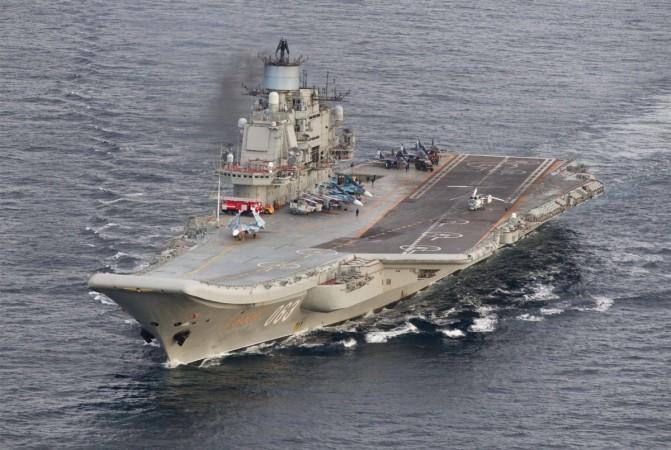
Russia's deployment of the largest aircraft carrier Admiral Kuznetsov to Syria in support of its ally President Bashar Al-Assad has raised questions. The western media has been critical of Russian President Putin's participation in the Syrian civil war and this has been reflected in its readings of the Russian Navy operations.
Nevertheless, President Vladimir Putin's military deployment in Syria is seen as Moscow's attempt to project its military might. It wants to be seen as a resurgent power and impress upon potential defence hardware buyers, Bloomberg reported.
It has been dubbed as the largest Russian naval deployment since the Cold War. Militarily speaking, Russian systems have been performing well. Russia has been conducting air strikes using its ground-based aircraft on rebel and ISIS strongholds since September 2015. Since then, it has been making regular combat sorties in an efficient way. It has also used cruise missiles on rebel targets and the new T-90 tanks have survived missiles. Another effective weapon that Russia deployed has been the advanced S-400 air-defence system.
But then what has been considered as a blunder was the sending of Admiral Kuznetsov to Syria. Here is why the western media thinks Russia is embarrassing itself.
Reason 1:
The Kuznetsov was never intended for strike missions but to protect Russian waters. With only 15 planes on board the aircraft carrier, not much can be achieved from the ground offensive it has launched to help the Syrian government, the report noted.
Reason 2:
Admiral Kuznetsov, according to the report, is "embarrassing to look at" as belches black smoke all along and has tugboats on standby in the event of breakdowns, which is reportedly frequent.
Reason 3:
It features "ski-jump" configuration, which is Russian answer to flat decks. The report terms it as a "Russian admission of technological defeat," since Moscow does not have catapults that give it enough thrust to propel the aircraft into the air.
Reason 4:
Apart from the fact that this is a lone aircraft carrier and is the flagship of the battle group in Syria, Kuznetsov has been in service since the mid-1980s. It has made few deployments and the furthest has been to the Mediterranean.
Reason 5:
The warship has been accident-prone. There was an issue when the freezing of a pipe resulted in only 25 toilets being usable for a crew of 2,000. In 2009, it spilled oil and that led to one sailor dying due to a fire. It had a brake down in 2012, and had to be towed for thousands of kilometres.
Recently, the warship was stuck by another mishap when a Su-33 fighter aircraft crashed due to defective arrestor while landing on the 43,000 tonner. Last month too, there was a similar accident but with a MiG-29 fighter.
Meanwhile, IHS Janes had reported that the Russian Navy has been expecting problems with the aircraft carrier and has been moving the aircraft on the carrier to a Syrian airfield.
Export potential?
After several years of delay, and much haggling over the price, a refurbished Admiral Gorshkov was sold to India in 2004 for $2.35 billion, which was rechristened as INS Vikramaditya. It features short take-off but arrested recovery (STOBAR) configuration. China took delivery of the Varyag in the late 1990s from Ukraine, which has now been rechristened to Liaoning.
Both the counties have made known discontent with the ships.
Though Russia has some amazing weaponry in its arsenal, Admiral Kuznetsov is definitely not among them. It has been termed as "antique" carrier and it is time to scrap it.
But Admiral Kuznetsov serves well as propaganda for Russians, who want to show its citizens that it is a war that matters. What the old Russian aircraft carrier has actually done is gained the attention of the western media for all the wrong reasons.














